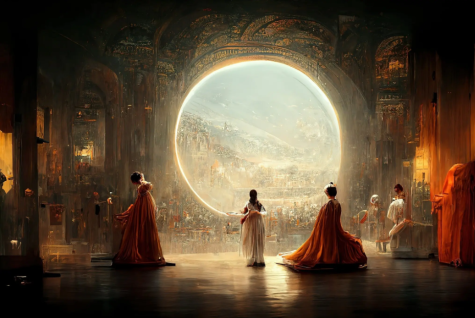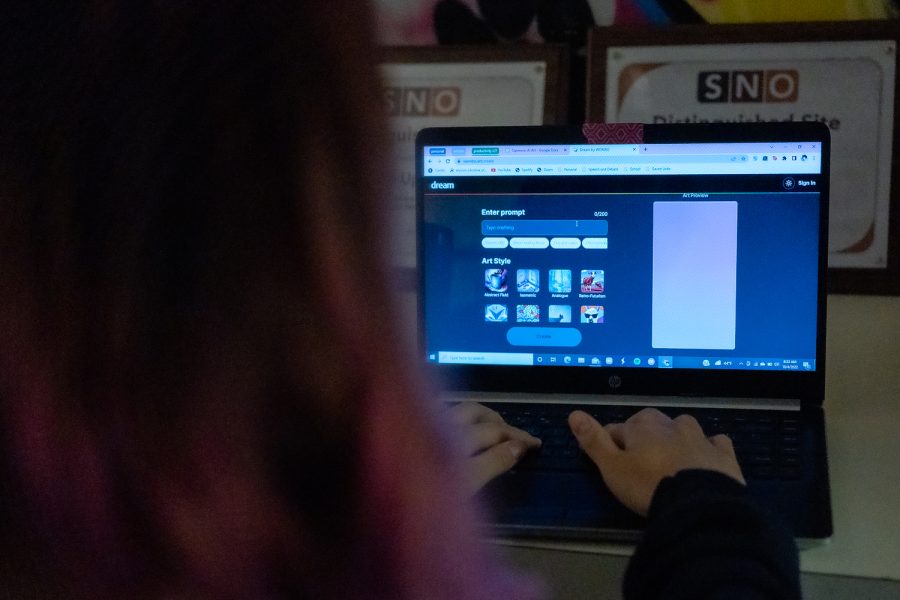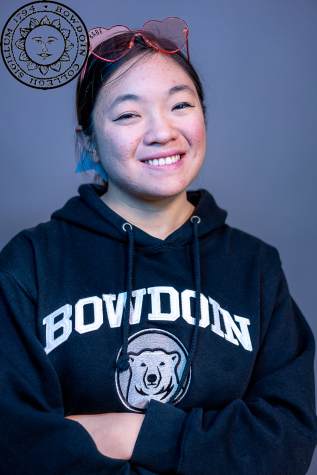AI and the Future of Art
Rapid advancements in artificial intelligence pose challenges to our traditional understanding of human creativity.
Wombo Dream is a website that uses neural networks to create art from a written prompt.
October 13, 2022
For decades, the digitization and innovation that has marked developments in artificial intelligence (AI) has brought with it a persistent, and often justified, fear: a loss of jobs. From security to marketing to typically blue collar jobs, worries have increased significantly about what, exactly, the growth of AI means for the job market in the coming years. To most people, creative jobs, like artists or musicians, seemed safe from the growth of AI–after all, creativity seems like a fundamentally human trait, doesn’t it?
However, just this year, during Colorado’s State Fair’s annual art competition, 39-year-old Jason M. Allen used an artificial intelligence art program called Midjourney that turns lines of text into hyper-realistic graphics to win first place. In doing so, a wave of controversy came forth. Artists have long struggled to make the median yearly income, and fears of a further loss in income are not unfounded. Even though AI has existed since the mid-20th century, an upswing in free, well-designed art available to amateurs will likely not bode well for professionals.
AI art raises issues of plagiarism and copyright infringement as well. Artificial intelligence cannot create art out of whole cloth. Apps like DALL-E 2 and Midjourney create art from scraping images online and tracing patterns to learn how to create in the same style.

Greg Rutkowski, a Polish digital artist who draws fantasy landscapes in a classical painting style, is one of many artists that has inspired people using AI to make art. Rutkowski has a background in art and a hefty portfolio–from games like Sony’s Horizon Forbidden West and Ubisoft’s Anno to tabletop RPGs like Dungeons & Dragons and Magic: The Gathering. According to Lexica, a website that tracks over 10 million images and prompts generated using the artificial intelligence Stable Diffusion, Rutkowski’s name has been a prompt for over 93,000 images.
Thus far, Rutkowski can’t opt out of his art being used as a prompt or to have his work removed. Similarly, Carolyn Henderson, who manages her husband Steve Henderson’s art, emailed the Stability AI attempting to wipe the database of her husband’s work. She commented that her email was “neither acknowledged nor answered.”
Questions of copyright in terms of AI art don’t just affect digital artists. Karla Ortiz, a San Francisco-based artist whose work was similarly in Stable Diffusion’s database, said, “It’s not just artists… It’s photographers, models, actors and actresses, directors, cinematographers. Any sort of visual professional is having to deal with this particular question right now.”
While innovation has a historic precedent in the loss of jobs, one must consider how a drop in employment will affect an industry already undervalued by capitalist society. Rutkowski, as an artist, admires the innovation that AI art represents, but he cannot help but worry about his own job.
“It’s a cool experiment,” Rutkowski said. “But for me and many other artists, it’s starting to look like a threat to our careers.”
Just this year, LinkedIn lost a case in an appeals court, and the court ruled that scraping public data on the internet was not in violation of the Computer Fraud and Abuse Act. In even publicizing their work, many artists can put themselves in danger for a loss in profit from AI scraping. Of course, these artists are stuck between a rock and hard place–without publicizing their art, they have no profit or advertisement, and if they do, AI scraping can sap their profits.
The existence of art made by a computer brings with it questions of the Turing Test as well. In 1950, computer scientist Alan Turing proposed the Imitation Game, a thought experiment in which an interviewer converses using a typewriter with both a machine and a human. Turing suggested that when the interviewer would not be able to tell the difference between them, the machine could be considered able to think.
Already, AI has passed the Turing Test in terms of both art and music. In 2018, Dartmouth hosted the first seminal AI summer conference, which presented PoetiX, LimeriX and LyriX competitions for poetry and lyrics, as well as a DigiKidLit competition for children’s literature. These pieces of writing passed the Turing Test with flying colors.
It should be noted that the AI sector has largely moved away from the Turing Test as a benchmark, even as AI grows increasingly realistic. However, the goals of AI still remain making technology as human-like as possible. From translation algorithms to voice assistants to art, computer scientists have set their sights on making AI indistinguishable from humans.
For all intents and purposes, it can be argued that AI can think, which prompts a reevaluation of our understanding of copyright and plagiarism in regard to art.
“Open-source AI is a tremendous innovation, and we appreciate that there are open questions and differing legal opinions. We expect them to be resolved over time, as AI becomes more ubiquitous and different groups come to a consensus as to how to balance individual rights and essential AI/ML research,” said one of Stability AI’s researchers, Tom Mason. “We strive to find the balance between innovating and helping the community.”
Further, in terms of economic concerns, we must ensure that artists do not simply disappear in favor of AI art. This is, of course, a matter of what we must learn to value, an entirely different topic. Perhaps, as is the case in other fields, human and AI coexistence will benefit the field of art.
I do fear that I may be taking a quite conservative anti-technology view of a new innovation, as it is not my intention. Developments in technology have contributed to a mixture of benefits and detriments to society, and they will likely continue to. We should not necessarily back away from artificial intelligence, either. Despite the issues that innovation brings with it, advancements in technology are still important. These innovations will continue with or without resistance.
But it is admittedly terrifying to consider that technology can replicate human creativity, and the deception inherent in our current AI industry remains disconcerting. As the line between between humans and machines grown blurred, perhaps it is time to reevaluate the direction we are steering artificial intelligence towards.
As Jeremy Khan, a journalist and critic of artificial intelligence, wrote, “The Turing Test’s most troubling legacy is an ethical one: The test is fundamentally about deception, and here, the test’s impact on the field has been very real and disturbing.”












